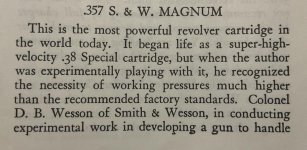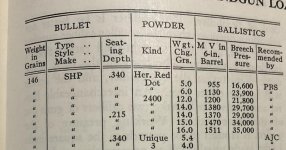Just adding a few things to my post #5.
This is all from Phil Sharpe's book (1937).
First is his opening comment on the 357.
Next, excerpt of 357 data.
Then, excerpt of 38 Special data.
Notice, the use of the same powder and bullet. Compare the pressure, velocities, and powder charge weights. The only difference is OAL. This is a little confusing as Sharpe expresses it as seating depth (ie: deeper in the 357 case by a factor equivalent to the difference in case lengths.)
Sharpe worked hard and intelligently, and had his results laboratory pressure tested. That's not necessarily a recommendation, though, especially the 16.0 gr. charge!
Orionengnr, I think you found some good loads!
This is all from Phil Sharpe's book (1937).
First is his opening comment on the 357.
Next, excerpt of 357 data.
Then, excerpt of 38 Special data.
Notice, the use of the same powder and bullet. Compare the pressure, velocities, and powder charge weights. The only difference is OAL. This is a little confusing as Sharpe expresses it as seating depth (ie: deeper in the 357 case by a factor equivalent to the difference in case lengths.)
Sharpe worked hard and intelligently, and had his results laboratory pressure tested. That's not necessarily a recommendation, though, especially the 16.0 gr. charge!
Orionengnr, I think you found some good loads!



